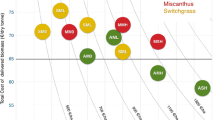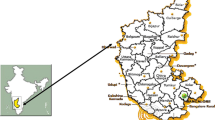Abstract
Tree wind break systems are found in many parts of the world. In particular in windy and arid regions they help to increase crop yields and reduce crop water consumption. Due to these reasons, tree wind breaks have a long tradition in Central Asia and were strongly propagated there during Soviet Union times. After the Soviet Union had disintegrated and the countries in Central Asia had become independent, energy supplies from Russia ceased and fuel wood became the primary energy source for large parts of the population, in particular rural population. Consequently, most of those tree wind breaks were cut down for fuel wood during the 1990s. Now, governments wish to restore these systems, but many farmers are skeptical about the economic returns from investment in tree wind breaks. Against this background, this study calculated revenues, costs, and profits for tree wind break systems of poplars combined with wheat, barley, corn, alfalfa, cotton, and rice in Kyrgyzstan, based on interviews and field observations. Tree wind breaks with more than one row of trees (multiple row type) did not result in financial gains for most crop tree wind break systems compared to open field conditions, while single tree wind breaks were cost-neutral or resulted in small economic gains, also under different discount rates and revenues attained from crops and trees. Among the different grid sizes, the 200 m × 200 m grid attained the highest financial surplus compared with open field conditions and other grid sizes. Thereby, effectively it is recommended to establish tree wind breaks along existing field borders or irrigation ditches while keeping an average distance between tree lines of 200 m, in order not to impede farm operations.


Similar content being viewed by others
References
Albenskii AV, Kalashnikov AF, Ozolin GP, Nikitin PL, Surmach GP, Kulik NF, Senkevich AA, Kasyanov FM, Pavlovskii ES, Roslyakov NV (1972) Agroforestry melioration. Lesnaya promyshlennost, Moscow
Alemu MM (2016) Ecological benefits of trees as windbreaks and shelterbelts. Int J Ecosyst 6:10–13
Azarov A, Maurer MK, Weyerhaeuser H, Darr D (2019) The impact of uncertainty on smallholder farmers’ income in Kyrgyzstan. Agric Rural Dev Trop Subtrop 120:183–195. https://doi.org/10.17170/kobra-20191127816
Brandle JR, Hodges L, Zhou XH (2004) Windbreaks in North American agricultural systems. Agrofor Syst 61:65–78
Bulychev A, Onishenko L (1979) Field protective forest lines and their effectiveness in Chuy Valley. Kyrgyzstan, Frunze
Caborn JM (1957) Shelterbelts and microclimate. Forestry Commission Bulletin No. 29. Edinburgh
Cleugh HA, Prinsley R, Bird PR, Brooks SJ, Carberry PS, Crawford MC, Jackson TT, Meinke H, Mylius SJ, Nuberg IK, Sudmeyer RA, Wright AJ (2002) The Australian National Windbreaks Program: overview and summary of results. Aust J Exp Agric 42(6):649–664
Danilov G (1971) Protective forest stands and system of cultivation. Lesnaya Promyshlennost, Moscow
Dwivedi RP, Singh KKR, Rizvi RH, Chauhan J (2007) Socio-economic analysis of agroforestry systems in western Uttar Pradesh. Indian Res J Ext Edu 7:18–22
EURAF (2020) Agroforestry in Ukraine. https://euraf.isa.utl.pt/countries/ukraine. Assessed 3 Apr 2020
FAOSTAT (2020) http://www.fao.org/faostat/en/#data. Assessed 15 Mar 2020
Ghan PA, Djanaeva VM, Karafa-Korbut IG, Krivosheeva LS, Kunchenko AI, Orlova NI, Protopopov GF, Prutenskii DI, Tkachenko VI (1961) Trees and shrubs of Kyrgyzstan. Academia NAUK Kyrgyz SSR, Frunze
Isebrands JG, Richardson J (2014) Poplars and Willows-Trees for Society and the Environment. FAO CABI
Jain SK, Singh P (2000) Economic analysis of industrial agroforestry: poplar (Populus deltoides) in Uttar Pradesh (India). Agrofor Syst 49:255–273
Kalashnikov A (1969) Field protective forest lines and their influence on the yield. Ryazan Regional Printing House, Ryazan
Kayser B (2020) Hecken als Ertragsfaktor. http://www.agroforst.de/3-ertragshecken.html. Assessed 3 Apr 2020
Kort J (1988) Benefits of windbreaks to field and forage crops. Agr Ecosyst Environ 22(23):165–190
Lamers JPA, Michels K, Vandenbeldt RJ (1994) Trees and windbreaks in the Sahel: establishment growth nutritive and calorific values. Agrofor Syst 26:171–184
Missall S, Welp M, Thevs N, Abliz A, Halik Ü (2015) Establishment and maintenance of regulating ecosystem services in a dryland area of central Asia illustrated using the Kökyar Protection Forest Aksu NW China as an example. Earth Syst Dyn 6:359–373
Monteiro SRS, Martins C, Dias AMPG, Cruz H (2020) Mechanical performance of glulam products made with Portuguese poplar. Eur J Wood Wood Prod 78:1007–1015
National Agroforestry Center (2020) Windbreaks. U.S. Department of Agriculture. https://www.fs.usda.gov/nac/practices/windbreaks.php. Assessed 2 Apr 2020
National Statistical Committee of the Kyrgyz Republic (2020) Open data. http://www.stat.kg/en/opendata. Accessed 07 Apr 2020
Ontario Federation of Agriculture (2020) Best management practices field windbreaks. http://www.omafra.gov.on.ca/english/environment/bmp/AF167.pdf. Assessed 2 Apr 2020
Peri PL, Bloomberg M (2002) Windbreaks in southern Patagonia Argentina: a review of research on growth models windspeed reduction and effects on crops. Agrofor Syst 56:129–144
Peterson EB, Peterson NM, McLennan MS (1996) Black cottonwood and balsam poplar managers. Handbook for British Columbia. Ministry of Forests Canada
Republic of Tajikistan (2014) Fifth national report on preservation of biodiversity on the Republic of Tajikistan. National Center on Biodiversity and Biosafety of the Republic of Tajikistan (NCBB). Dushanbe. https://www.cbd.int/doc/world/tj/tj-nr-05-en.pdf
Ruppert D, Welp M, Spies M, Thevs N (2020) Farmers’ perceptions of tree shelterbelts on agricultural land in rural Kyrgyzstan. Sustainability 12:1093. https://doi.org/10.3390/su12031093
SAEPF (State Agency of Environment and Forests Kyrgyzstan) 2017 Biodiversity conservation priorities of the Kyrgyz Republic till 2024. https://www.cbd.int/doc/world/kg/kg-nbsap-v3-en.pdf
Schroeder WR, Kort J (1989) Shelterbelts in the Soviet Union. J Soil Water Conserv 44:130–134
State Committee of Turkmenistan for Environmental Protection and Land Resources (2018) National Forest Program. http://turkmenistan.gov.tm/?id=3309. Assessed 25 Jan 2018
Stepanov AM (1987) Agroforestry melioration in irrigated lands. Agropromizdat Moscow
Strelkovskii N, Komendantova N, Sizov S, Rovenskaya E (2020) Building plausible futures: scenario-based strategic planning of industrial development of Kyrgyzstan. Futures 124:102646. https://doi.org/10.1016/j.futures.2020.102646
Strenge E, Thevs N, Aliev K, Eraaliev M, Lang P, Baibagysov A (2018) Water consumption of populus alba trees in tree shelterbelt systems in Central Asia—a case study in the Chui Valley, South Eastern Kazakhstan. Central Asian J Water Res 4:48–62. https://doi.org/10.29258/CAJWR/2018-RI.v4-1/48-62.eng
Susa NI (1959) Agroforestry melioration. Governmental Publishing House for Agriculture, Moscow
Thevs N, Gombert AJ, Strenge E, Lleshi R, Aliev K, Emileva B (2019) Tree wind breaks in Central Asia and their effects on agricultural water consumption. Land 8:167–183. https://doi.org/10.3390/land8110167
Tomás A, Palmer JHN, Graves A, Garcia de Jalón S, Burgess PJ (2018) Integrating a financial module in the web-ecoyield-safe model for bioeconomic assessment of agroforestry ecosystems. In: 4th European agroforestry conference—agroforestry as sustainable land use, 28–30 May 2018, Nijmegen, The Netherlands
Tribunskaya V, Kostina N, Sherbakova L, Astafiev N (1974) Agro-economic effectiveness of shelterbelts. Lesnaya Promyshlennost, Moscow
UNDP (2015a) Concept for conservation and sustainable use of the biological diversity of the Republic of Kazakhstan until 2030. Astana. http://www.fhc.kz/conventions/files/kz-nbsap-rus.pdf
UNDP (2015b) Fifth National Report of the Republic of Uzbekistan on Conservation of Biodiversity. https://www.cbd.int/doc/world/uz/uz-nr-05-en.pdf
UNECE (2019) Forest Landscape Restoration in the Caucasus and Central Asia—challenges and opportunities. Background paper for the Ministerial Roundtable on Forest Landscape Restoration in the Caucasus and Central Asia, 21–22 June 2018, Astana, Kazakhstan. http://www.unece.org/fileadmin/DAM/timber/publications/DP-72-flr-cca-en.pdf
Van Acker JCR, Jiang X, Bulcke J (2020) Innovative approaches to increase service life of poplar lightweight hardwood construction products. Current topics and trends on durability of building materials and components. https://www.scipedia.com/public/Acker_et_al_2020a
Vasilyev ME (1980) Melioration through forests and harvest. Kainar, Almaty
Vorobiev G, Anuchin N (1985) Forest encyclopaedia. Soviet Encyclopaedia, Moscow
Wandel J, Pieniadz A, Glauben T (2011) What is success and what is failure of transition? A critical review of two decades of agricultural reform in the Europe and Central Asia region. Post-Commun Econ 23(2):139–162
Wang SH, Zhang LZ, Zhang DS, van der Werf W, Evers JB, Sun HQ, Su ZC, Zhang SP (2016) Density responses and spatial distribution of cotton yield and yield components in jujube (Zizyphus jujube)/cotton (Gossypium hirsutum) agroforestry. Eur J Agron 79:58–65
WFP (World Food Program) 2020. WFP Kyrgyz Republic Country Brief. https://docs.wfp.org/api/documents/WFP-0000113476/download/?_ga=2.268292878.1698452485.1586425537-188563853.1586425537. Assessed 15 Mar 2020
World Bank (2019) Real interest rate (%)—Kyrgyz Republic. https://data.worldbank.org/indicator/FR.INR.RINR?locations=KG. Assessed 15 Dec 2020
Yakovleva N (2003) Quality and productivity of domesticated poplar hybrids in Kyrgyzstan. Ilim, Bishkek
Zheng X, Zhu JJ, Xing ZF (2016) Assessment of the effects of shelterbelts on crop yields at the regional scale in Northeast China. Agric Syst 143:49–60
Acknowledgement
This study was undertaken with support from the Federal Ministry of Economic Cooperation and Development of Germany (BMZ), through the Advisory Service on Agricultural Research for Development (BEAF) under Deutsche Gesellschaft für Internationale Zusammenarbeit (GIZ), Germany. BMZ funded a research grant of 100,000 EUR. Niels Thevs’ position as an integrated expert at the World Agroforestry Center as well as the sap flow equipment and the climate stations were co-funded by BMZ as part of the Center for International Migration and Development (CIM) program. Students, who contributed to collect data, were funded by DAAD programs Promos and East Partnerships and by ASA (Invent), respectively. We thank the land owners and village administrations in the study sites for their support and permission to work on their land. Furthermore, we thank the reviewers for their valuable comments.
Author information
Authors and Affiliations
Corresponding author
Additional information
Publisher's Note
Springer Nature remains neutral with regard to jurisdictional claims in published maps and institutional affiliations.
Rights and permissions
About this article
Cite this article
Thevs, N., Aliev, K. Agro-economy of tree wind break systems in Kyrgyzstan, Central Asia. Agroforest Syst 97, 319–334 (2023). https://doi.org/10.1007/s10457-021-00617-7
Received:
Accepted:
Published:
Issue Date:
DOI: https://doi.org/10.1007/s10457-021-00617-7




